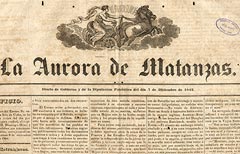2.6 Political-economic thought and its literary expressions in the period prior to the revolutionary outbreak of 1868, journalism

This period was determined by political contradictions surrounding the aspiration for independence and the fear of an anti-colonialist revolution that would jeopardize the country’s economic development. Annexationism and reformism were emerging as alternatives, but the infeasibility of these currents to resolve the issues arising from an eminently nationalist ideology became increasingly evident.
In 1862 the newspaper “El Siglo” was founded by José Quintín Suzarte, bought the following year by a group of shareholders, it ceased publication in 1868, perhaps due to the imminence or after the outbreak of the Ten Years’ War, its director during this period was Francisco de Frías, Count of Pozos Dulces, recently arrived from Europe, who gave it a conciliatory reformist tendency in political matters, combined with a surprising versatility in the treatment of humanistic themes and especially those related to science and technology, with a focus on the development of the country.
The work carried out by the intellectuals who gathered around “El Siglo” included a broad campaign to embrace reformist ideas, which enjoyed some support among the population and elicited some response from the colonial authorities. Essentially, the Ministry of Overseas Affairs convened the Information Board to hear the requests of representatives from Cuba and Puerto Rico. It is known that these demands were ignored, and in this sense, reformism and its almost resounding failure certainly contributed to the definitive establishment of independence ideas.
The concept of peaceful evolution was deeply rooted in the intellectual community behind the development of this journal; however, its abolitionist views and, in general, its support for scientific development and the promotion of education and other issues of positive social impact—within the framework of the unquestioned division of society into classes—gave this publication a significant role in the movement of ideas prior to the outbreak of the Ten Years’ War, based on the erudition and talent of its contributors.
In 1865, under the direction of Saturnino Martínez, the weekly magazine “La Aurora” was founded, which was also in the public eye until 1868, dedicated to artisans – probably the cigar makers, who at that time were called “artisans” – it was the first of its kind in the country because it defended the rights and interests of a social class generally without representation in cultural officialdom, it had numerous prominent collaborators in the letters, such as Joaquín Lorenzo Luaces, José Fornaris, Antonio and Francisco Sellén and Luis Victoriano Betancourt, among others.
In its first issue, under the headline “Profession of Faith,” its contributors expressed: “…we have come to contribute our grain of sand to the great edifice that humanity is erecting. Cosmopolitans by conviction, we have come to express our ideas with the freedom permitted us and within the limits imposed on a publication of our nature. We have come to join forces with that group of intellectual workers who show such zeal for the advancement of science and literature and for the dissemination of enlightenment among the masses of society.”
La Aurora, El Siglo, and most of the newspapers published during this period—since this allowed them to be more competitive—had sections dedicated to literature and poetry, although sometimes without the necessary rigor in the selection of texts. From a reformist orientation that prevailed in the journalistic landscape, especially because the independence movement had to remain hidden, they contributed to the development of Creole culture and, in the case of La Aurora, also to the cultural promotion and class consciousness of workers, which would contribute to the formation of nationalist thought and a literary expression consistent with it.








